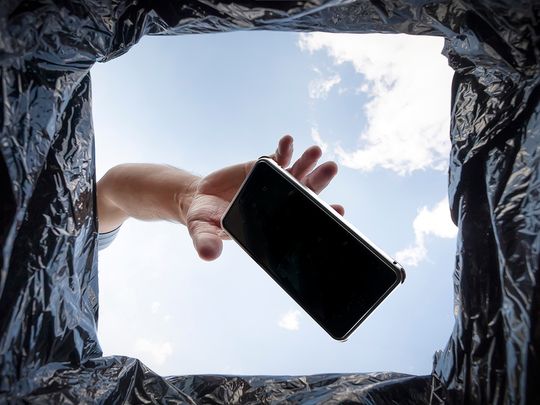
There’s a new iPhone, out in stores right now.
Many of us are already looking more closely at our smartphones, checking them for flaws or issues – is it time to replace our phones with shiny new ones?
The problem with this thought process is that, in all likelihood, there’s nothing wrong with our phones. In fact, with proper care, they can last for a long time, saving us money and cutting down on e-waste.
According to a December 2023 study in Consumer Affairs, a US-based journal of consumer research, over 55 per cent of mobile phone users upgrade their devices every two to three years. About 12 per cent of them change their phones every year.
We spoke with Dr Obada Al Khatib, a discipline leader in electrical, computer and telecommunication engineering, and assistant professor at the School of Engineering in University of Wollongong Dubai. He said: “The proliferation of smartphones has increased the rate of e-waste, with rapid cycling through of the product. This presents one of the greatest environmental, social, and economic challenges.” Scroll down to get his take on the larger impact of our individual decisions to get rid of phones before their time is due.
So, if you’re deliberating on what to do about your phone, take a closer look at it. For some, buying a new phone right now is necessary – urgent, even – because of software or hardware issues, poor battery life, broken screens, or a number of other issues. There are plenty of new releases this year that meet their needs, from the Samsung Galaxy S24 to the newly launched iPhone 16 series.
For the rest of us, it’s worth considering ways to extend our smartphones’ lifespan. Dr Al Khatib guided us on ways to do so, below, with minimal expenses and contributions to e-waste. One great way is to take advantage of Amazon’s phone repair service, where technicians can collect the device from your home, fix it, and deliver it back to you, in a matter of hours.
Don’t forget to become an Amazon Prime member, before you buy any of the items on our list, to receive free, fast delivery.
1. Protect your phone
Nowadays, most smartphones come with Ingress Protection ratings for dust and water resistance. They can survive splashes and raindrops, with some even enduring being submerged in water. Today’s phones are also more resistant to scratches and drops. But it is always a good idea to add further layers of protection. Dr Al Khatib advised: “Use hard cases to protect your device against accidental drops, scratches, and other types of physical damage. Also keep your screen safe from scratches and cracks with high-quality screen protectors.” This protection would also pay off when you’re ready to trade in or sell your phone, since the phone would be in better shape than expected. We chose Apple’s range of silicone cases with MagSafe ability – select from a range of colours. Spigen’s Tough Armour case, designed for the Samsung Galaxy S24 offers lasting protection, with three layers of foam and hard polyurethane. Check out more phone cases here.
2. Prioritise battery health
Caring for your phone battery’s health is vital for its longevity. It all starts with a good charger. Since most smartphone manufacturers don’t include charging bricks when they sell devices, it’s up to you to buy one from a reputable brand, or better yet, from the manufacturer itself. Dr Al Khatib said: “OEM (original equipment manufacturer) chargers are always great for maintaining good health of the battery and preventing it from possible damage.”
But it’s not enough to know where to charge – how and when are important considerations, too. As unlikely as it may seem, experts recommend that you do not charge your phone to 100 per cent regularly; charging your phone all night long can also be disastrous, since it causes the phone battery to degrade. Over time, your phone’s battery will begin to lose its charge much faster.
Fortunately, many phones now include optimised charging features which stop charging at 85 per cent to preserve the battery. If you don’t see this feature active on your phone, open Settings, tap Battery, and then select the percentage limit at which you’d like charging to halt.
Other ways to preserve battery life come in the form of user behaviour. Dr Al Khatib shared tips: “Conserve the battery by changing device settings. This includes dimming the screen brightness, minimising refresh of apps running in the background, and managing notifications.” You can also reduce your screen timeout to under 60 seconds, so that the phone’s screen automatically turns off if it’s left idle. Lastly, switch on the phone’s low-power mode to help it last longer.
3. Keep it clean
A few minutes of your time and effort can help make a big difference to your phone’s lifespan. Wipe its screen clean with a microfibre cloth and non-streak cleaning solution, and make sure not to neglect its charging port and speaker grilles. When you clean these areas frequently, you avoid the problems caused by long-term build-up of dust and lint, which can eventually lead to charging issues, overheating, or worse. Ultraviolet sanitisers, which can charge your phone, even as they remove 99.9 per cent of germs and bacteria, are also useful devices that take care of your phone's hygiene.
4. Manage phone storage
We’re constantly taking photos and videos, playing mobile games and listening to stored music files. All of these things add up, in terms of storage, and this, in turn, can affect the phone’s overall speed and performance. If your phone is struggling with storage space, it has to work harder, causing its central processing unit (CPU) and random access memory (RAM) to overload.
One of the best ways to stop this problem from becoming a bigger issue, is to offload as many old photos, videos and music as you can into external or cloud storage. The iPhone offers iCloud services, and Android phones can opt for Google Drive or other cloud services to upload their photos and videos. If you’d prefer to move them into a physical drive, options like SanDisk’s Ixpand Flash Drive connect directly to both older and newer iPhones, as well as Android devices, thanks to two-in-one lightning and USB-C connectors.
5. Update your software and repair before buying
If your phone’s interface feels old and outdated, it’s time to go into Settings and make sure its software is up to date. New software can make using the phone feel more exciting; many updates include some of the same features that are available on newer models. Dr Al Khatib also advised installing updates to improve your smartphone’s security. Most smartphone manufacturers provide monthly or bimonthly security updates, so do keep an eye out for them.
Next, consider repairing your phone when you’re facing issues like cracked screens or battery replacement. iPhone users can take advantage of AppleCare+, an insurance plan that offers such services for free if you’ve signed up for it. Alternatives, like Amazon’s smartphone repair service, offers the convenience of collect-and-drop services, where technicians come to your home, diagnose the issue, and once agreed upon, fix and return your device in a matter of hours. Dr Al Khatib said: “[When people choose to] fix their devices, it tends to reduce electronic waste and considerably impacts the manufacturing of new gadgets. It is often much cheaper, compared to replacing the entire device, especially when there is minimal damage. Also, when your device is repaired, it automatically retains your personal data and settings, hence you will not have to transfer these to a new device.”
The implications of premature smartphone disposal

In March this year, the United Nation’s Global E-waste Monitor (GEM) revealed that the world’s generation of electronic waste is rising five times faster than documented e-waste recycling. In fact, the amount of e-waste produced in 2022 alone (an estimated 62 million tonnes), could fill 1.55 million 40-tonne trucks – roughly enough to form a bumper-to-bumper line encircling the equator.
These mind-boggling statistics just scratch the surface of the issue of e-waste – a global problem that has environmental, economic, and social concerns. Dr Al Khatib broke down the ways in which, e-waste compounds issues even further:
Environmental concerns
Hazardous materials: Electronic devices contain toxic materials that can contaminate soil, water, and air, if poorly managed.
Resource depletion: The extraction of raw materials for smartphone production contributes to resource depletion and environmental degradation.
Greenhouse gases: Manufacturing and the waste of electronic gadgets contribute to global warming.
Social and economic concerns
Digital divide: The rapid turnover of smartphones can exacerbate the digital divide, as older or lower-income individuals may struggle to afford the latest devices.
Economic waste: The early discard of functional mobile phones presents a significant economic loss.
Issues of ethics: The wages, working hours, and treatment of workers in the process of extraction and production of electronic equipment evokes serious ethical concerns regarding labour standards and rights.
A unified approach to the e-waste crisis
According to Dr Al Khatib, “to mitigate the negative impacts of smartphone obsolescence, a multifaceted approach is necessary”. He outlined steps that smartphone manufacturers, governments, and individuals could take to make a difference.
- Extended Producer Responsibility (EPR): This policy approach argues that manufacturers should take responsibility for the environmental and social impacts of their products throughout the whole product life cycle.
- Recycling and reusing initiatives: Such initiatives will recover valuable materials from e-waste, reducing the need for new resources. Governments, businesses, and consumers should support these recovery programs.
- Consumer education: Enhancing consumers' awareness regarding the environmental and social ramifications of electronic waste may promote responsible practices in both consumption and disposal.
- Technological innovation: Research and development should focus on developing more sustainable electronic devices with longer lifespans, modular designs, and easier repairability.
- Policy and regulation: Government should develop policies that guarantee responsibility in the management of e-waste, through setting targets for recycling rates, banning hazardous substances, and creating economic incentives related to sustainability.
How you can make your smartphone last longer
If you’re looking for a way to do your part, you can start by helping your phone perform optimally – for as long as possible.
Dr Al Khatib said: “The typical lifespan of a smartphone can fluctuate considerably, based on various determinants, including usage habits, maintenance practices, and the quality of the device. However, it's generally estimated that a well-maintained smartphone can last anywhere from three to five years.”
Here are some ways to keep your phone in fine form, according to our expert:
- Repair versus replace: Fixing a broken smartphone instead of purchasing another one is economically advantageous and also more beneficial for the environment.
- Regular software updates: Use recent software so as to leverage the benefits of security updates, bug fixes, and performance improvements.
- Battery care: Use original, manufacturer-sourced chargers, to keep your device in good health. Change battery settings, as preferred, to keep it running optimally. Keep your phone away from excessively hot or cold temperatures, as extreme temperatures may accelerate battery degradation.
- Clean your device: Maintain and sanitise your device, as required. You can clean your screen and the body of your mobile phone with a soft, lint-free cloth to remove dirt and smudges.
- Avoid debris accumulation in the charging port and headphone jack by periodically cleaning with a soft-bristled brush.
- Leverage hidden features: Explore your smartphone's advanced capabilities to enhance your experience and help you make the most out of it.
- Personalise your device: Tailor your smartphone's appearance and functionality to your preferences, so that it appeals to your unique taste and keeps you invested in ensuring its longevity.
- Use productivity enhancement tools: Utilise a task manager, note-taking applications, and calendars for effective work.
- Optimise storage: Manage the storage of your device by preventing it from getting too cluttered. By doing so, this will significantly extend the life of your smartphone, reduce electronic waste, and minimise environmental impacts related to device replacement.
- Increase security: Always keep your software up-to-date in order to minimise security threats and to protect your information.
- Establish data back-up protocols: Generate consistent back-ups of your important data to protect against unintended loss.
Our recommendations are independently chosen by Gulf News editors. If you decide to shop through links on our website, we may earn an affiliate commission, as we are part of Amazon Services LLC Associates Program.











